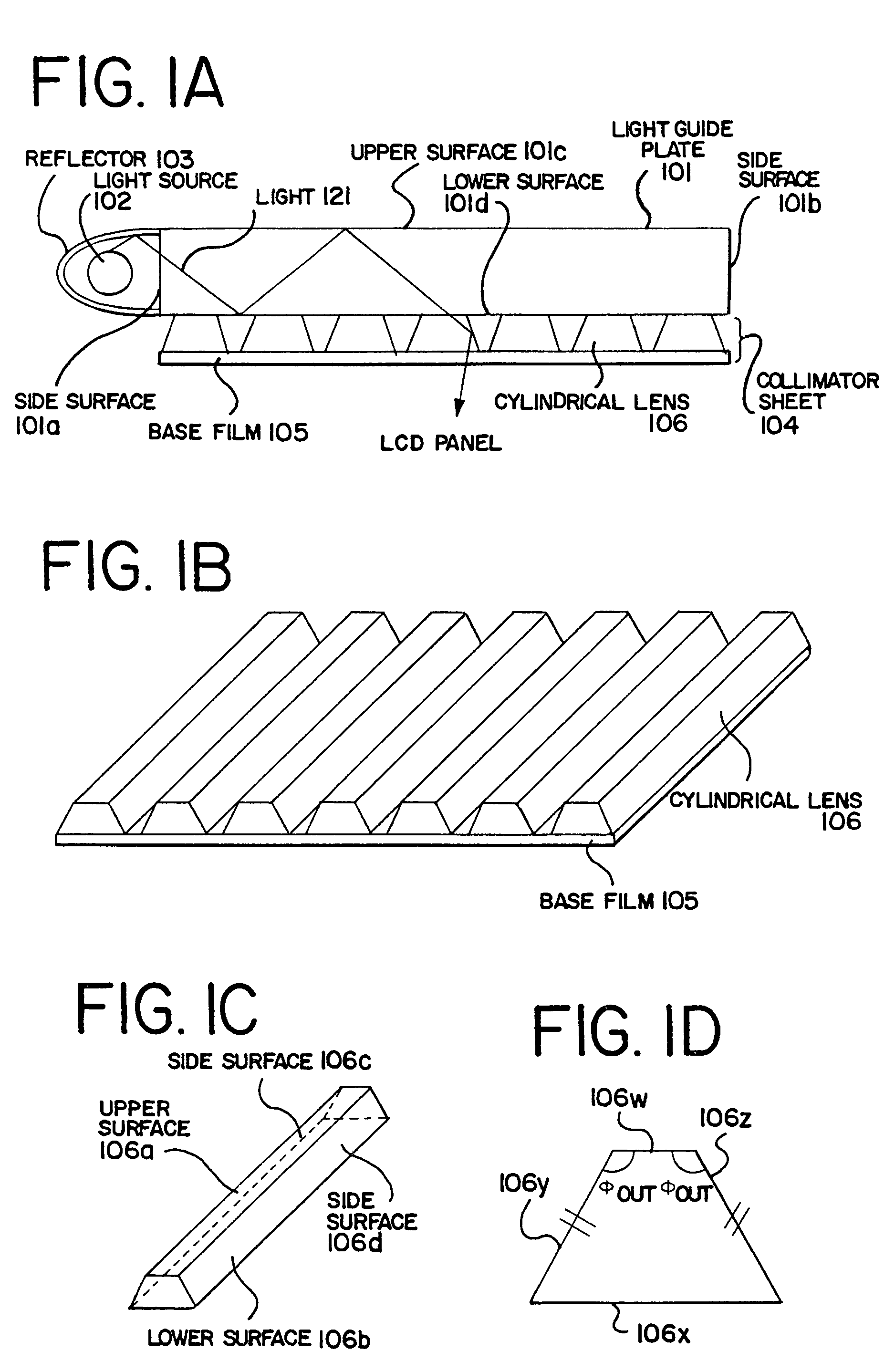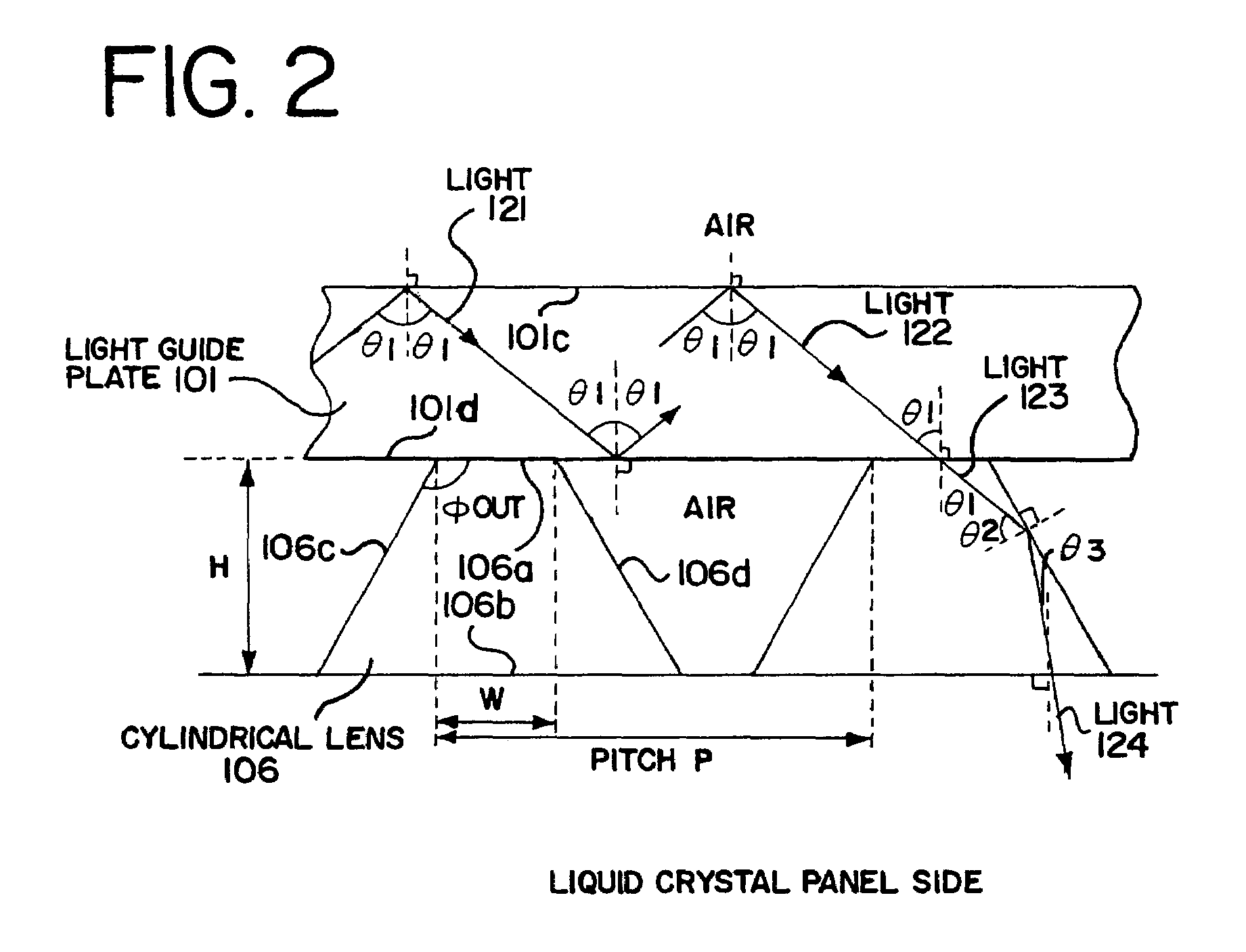Front light having a plurality of prism-shaped lenses
a prism-type front light and prism-shaped technology, applied in the field of front lights, can solve the problems of low light utilization efficiency, low light utilization efficiency of prism-type front lights, and drawbacks of reflective lcds, so as to improve light utilization efficiency, suppress light attenuation, and high light utilization efficiency
- Summary
- Abstract
- Description
- Claims
- Application Information
AI Technical Summary
Benefits of technology
Problems solved by technology
Method used
Image
Examples
embodiment 1
[0053]A front light in the present embodiment utilizes prism-shaped lenses each having an equally-sided trapezoidal cross-section in a plane perpendicular to side surfaces.
[0054]FIG. 1 illustrates a configuration of the front light in the present embodiment. More specifically, FIG. 1A shows a cross-sectional view of the front light, FIG. 1B shows a perspective view of a collimator sheet, FIG. 1C shows a perspective view of each prism-shaped lens, and FIG. 1D shows a cross-sectional view of the prism-shaped lens in a plane perpendicular to the side surfaces.
[0055]As shown in FIG. 1A, a light source 102 is disposed on a side surface 101a of a light guide plate 101, and a reflector 103 is further provided behind the light source 102. In addition, a collimator sheet 104 is provided so as to come into contact with a lower surface 101d of the light guide plate 101. For the purpose of clarification of the descriptions, an upper surface 101c of the light guide plate 101 refers to a surface ...
embodiment 2
[0090]In the present embodiment, one modified mode of the prism-shaped lenses in Embodiment 1 will be described. In Embodiment 1, each of the prism-shaped lenses has an equally-sided trapezoidal cross-section. However, as shown in FIGS. 3A to 3C, the light incident on the side surfaces 106c and 106d may transmit therethrough depending on the obtuse angle φout of the equally-side trapezoidal cross-section, thereby resulting in reduced light utilization efficiency. On the other hand, the lenses in the present embodiment are intended to overcome such disadvantages of the prism-shaped lenses having the trapezoidal cross-section, and allow the light incident on the upper surface of the prism-shaped lenses to stop its travel at the side surfaces thereof and be totally reflected therefrom.
[0091]FIG. 6 illustrates a configuration of the front light in the present embodiment. More specifically, FIG. 6A shows a cross-sectional view of the front light, FIG. 6B shows a perspective view of a col...
embodiment 3
[0099]While the prism-shaped lenses are used for the collimator sheet in Embodiments 1 and 2, lenses in the shape of solid of revolution (referred to as the rotational-body lenses in the present specification) are used in the present embodiment. The front light in the present embodiment has the same configuration as that in Embodiment 2, except for the collimator sheet which is a modified mode of that in Embodiment 2. FIGS. 8A and 8B illustrate the configuration of the collimator sheet in the present embodiment.
[0100]As shown in FIG. 8A, rotational-body lenses 306 are provided at equal intervals on a base film 305 made of PET so that an upper surface 306a of each of the rotational-body lenses 306 is in close contact with a lower surface of a light guide plate (not shown in FIG. 8A). The rotational-body lenses 306 and the light guide plate are made of the same material, of course. As shown in FIG. 8B, each of the rotational-body lenses 306 has a shape obtained by rotating an axially-...
PUM
| Property | Measurement | Unit |
|---|---|---|
| critical angle | aaaaa | aaaaa |
| critical angle | aaaaa | aaaaa |
| exiting angle | aaaaa | aaaaa |
Abstract
Description
Claims
Application Information
 Login to View More
Login to View More - R&D
- Intellectual Property
- Life Sciences
- Materials
- Tech Scout
- Unparalleled Data Quality
- Higher Quality Content
- 60% Fewer Hallucinations
Browse by: Latest US Patents, China's latest patents, Technical Efficacy Thesaurus, Application Domain, Technology Topic, Popular Technical Reports.
© 2025 PatSnap. All rights reserved.Legal|Privacy policy|Modern Slavery Act Transparency Statement|Sitemap|About US| Contact US: help@patsnap.com



